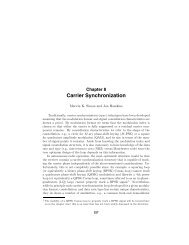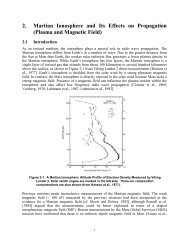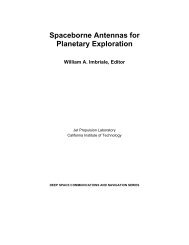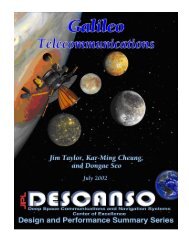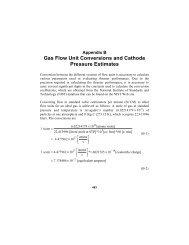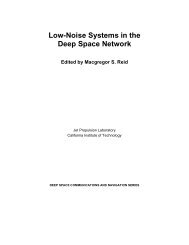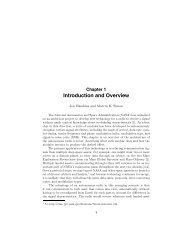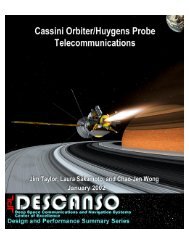Propagation Effects Handbook for Satellite Systems - DESCANSO ...
Propagation Effects Handbook for Satellite Systems - DESCANSO ...
Propagation Effects Handbook for Satellite Systems - DESCANSO ...
You also want an ePaper? Increase the reach of your titles
YUMPU automatically turns print PDFs into web optimized ePapers that Google loves.
Step 6 Calculate the attenuation exceeded <strong>for</strong> other percentage<br />
values of an average year from:<br />
AP = 0012 AOCO1 p-(0.546 + 0.043 109 P] (6.3-16)<br />
This relationship is valid <strong>for</strong> annual percentages from 0.001% to<br />
1.0%.<br />
6.3.2.4 Sample Calculation <strong>for</strong> the CCIR Model<br />
In this section the CCIR model is applied to a specific ground<br />
terminal case. Consider a terminal located at Greenbelt, MD., at a<br />
latitude of 38°N, and elevation above sea level of 0.2 km. The<br />
characteristics of the link are as follows:<br />
Frequency: 11.7 GHz .<br />
Elevation Angle: 29°<br />
Polarization: Circular<br />
Step 1 Figure 6.3-7 indicates that the terminal is in climate zone<br />
K, with a corresponding RO,Ol f 42 mm/h (Table 6.3-2).<br />
Step 2 The effective rain height, from Eq (6.3-11), is<br />
hr = 4.0 - 0.075(38 - 36) = 3.85<br />
Step 3 ‘I’he slant path length, horizontal projection, and reduction<br />
factor are determined from Eq.’s (6.3-12, -13, -14) r@spectiv@ly:<br />
Ls = (3.85 - 0.2)(/sin(29°) = 7.53<br />
LG = (7.53)cos(29°) = 6.58<br />
rp = 1/[1 + (0.045)(6.58)] =<br />
o.771<br />
6-35





